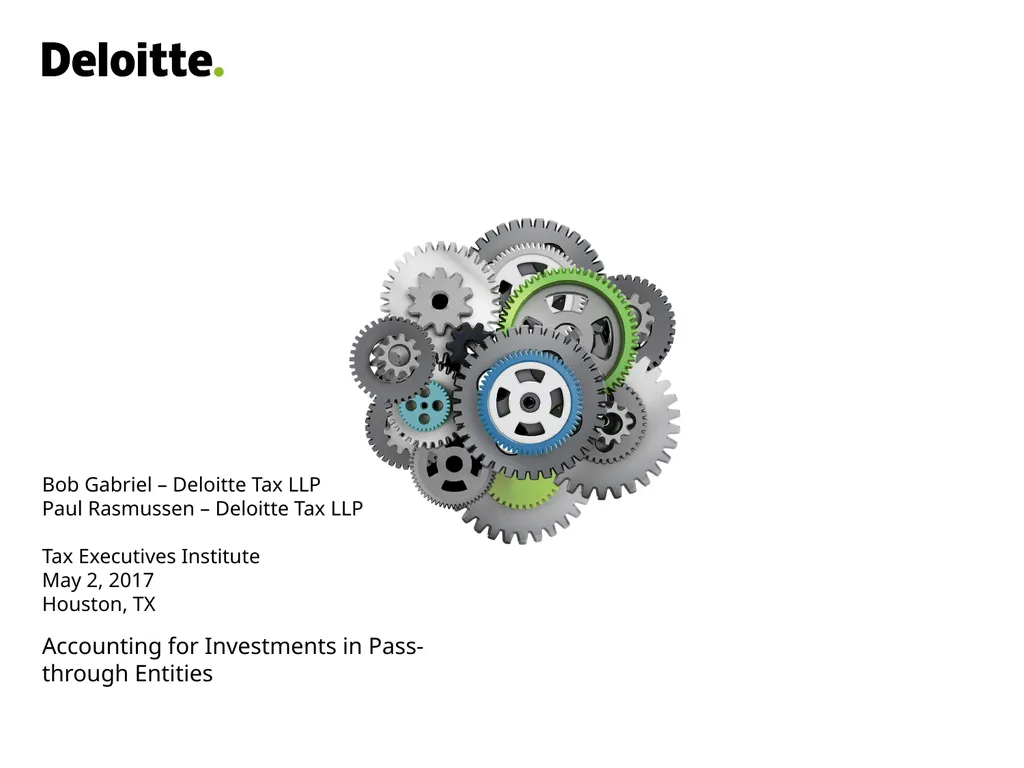Bob Gabriel – Deloitte Tax LLP Paul Rasmussen –
Author : trish-goza | Published Date : 2025-06-23
Description: Bob Gabriel Deloitte Tax LLP Paul Rasmussen Deloitte Tax LLP Tax Executives Institute May 2 2017 Houston TX Accounting for Investments in Passthrough Entities Agenda Overview Measuring deferred taxes for investments in passthrough
Presentation Embed Code
Download Presentation
Download
Presentation The PPT/PDF document
"Bob Gabriel – Deloitte Tax LLP Paul Rasmussen –" is the property of its rightful owner.
Permission is granted to download and print the materials on this website for personal, non-commercial use only,
and to display it on your personal computer provided you do not modify the materials and that you retain all
copyright notices contained in the materials. By downloading content from our website, you accept the terms of
this agreement.
Transcript:Bob Gabriel – Deloitte Tax LLP Paul Rasmussen –:
Bob Gabriel – Deloitte Tax LLP Paul Rasmussen – Deloitte Tax LLP Tax Executives Institute May 2, 2017 Houston, TX Accounting for Investments in Pass-through Entities Agenda Overview Measuring deferred taxes for investments in pass-through entities Other considerations Tax receivable agreements Questions Pass-through entities — Overview Tax consequences Investments in pass-through entities Pass-through entities such as partnerships are generally not taxable entities The exception would be when the partnership is a tax paying component as it relates to certain states, foreign jurisdictions, etc. e.g., NY business tax, foreign entity tax The owners of pass-through entities are generally taxable entities and recognize deferred taxes for any financial reporting/tax basis difference in the assets that they own, including interests in pass-through entities (i.e., the outside basis difference) A pass-through entity can be owned by another pass-through entity In that case, the current and deferred tax would be recorded by the taxable owner of the upper-tier pass-though entity An investor should generally not recognize deferred taxes on the financial reporting and tax basis differences associated with the pass-through entity’s assets and liabilities (i.e., the entity’s “inside basis differences”) Overview Inside and outside basis differences No deferred taxes are recorded in the partnership’s financial statements since tax consequences are borne by its partners If a partner is a taxable entity, deferred taxes are provided on temporary differences associated with that partner’s interest Investor 60% 40% P-Ship P-ship C Corp Deferred tax on temporary difference associated with the partnership investment No deferred tax recorded in the partnership’s financial statements Consolidated F/S Measuring deferred taxes for investments in pass‐through entities Overview Accounting treatment of partnership interest Note: Consultation with your attest firm is recommended Defining the relevant temporary difference(s) Deferred taxes are recorded on the difference between the financial statement amount of the investment in the partnership and its tax basis (i.e., the outside basis difference) Approaches for recording deferred taxes on outside basis differences Approach 1: “Look-through” method Apply the exceptions to the comprehensive model of recognition of deferred taxes (ASC 740-10-25-3) to the relevant portion of the outside basis difference Approach 2: “Outside basis” method Do not apply the exceptions and record deferred taxes on the entire outside basis difference Application of the two approaches will not necessarily result in an equal amount of deferred taxes being recognized Accounting treatment of partnership interest Financial reporting and tax basis Financial reporting basis in a partnership














